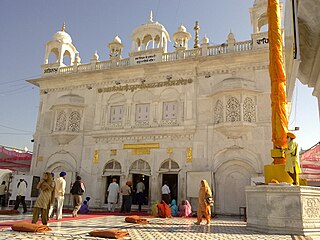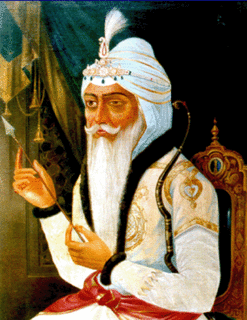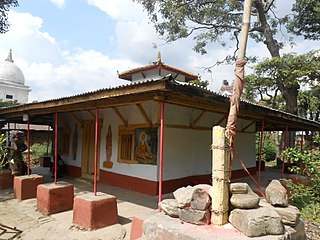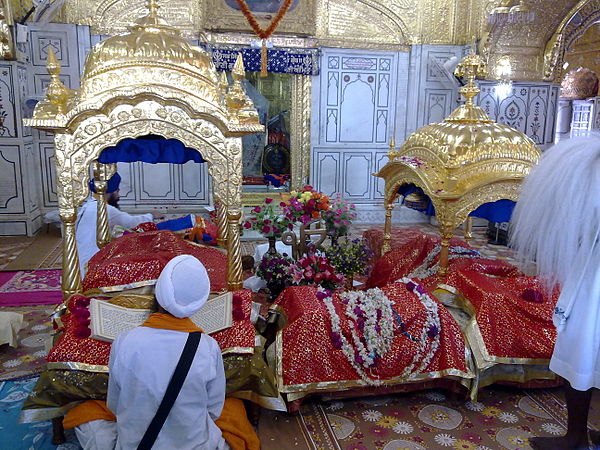
A gurdwara is a place of assembly and worship for Sikhs. People from all faiths, and those who do not profess any faith, are welcomed in Sikh gurdwaras. Each gurdwara has a Darbar Sahib where the current and everlasting guru of the Sikhs, the scripture Guru Granth Sahib, is placed on a takhat in a prominent central position. The raagis recite, sing and explain, the verses from the Guru Granth Sahib, in the presence of the congregation.

The following outline is provided as an overview of and topical guide to Sikhism:

The Damdami Taksal is a Sikh educational organization in India. Its headquarters are located in the town of Chowk Mehta, approximately 25 miles north of the city of Amritsar.

Anandpur Sahib, sometimes referred to simply as Anandpur Sahib, is a city in Rupnagar district (Ropar), on the edge of Shivalik Hills, in the state of Punjab, India. Located near the Sutlej River, the city is one of the most sacred places in Sikhism, being the place where the last two Sikh Gurus lived and where Guru Gobind Singh Ji founded the Khalsa Panth in 1699. The city is home to Keshgarh Sahib Gurdwara, one of the five Takhts in Sikhism.

The Takht Sri Darbar Sahib Damdama Sahib, one of the five Takhts or Seat of Temporal Authority of Sikhism, Takht Sri Damdama Sahib is in Bathinda in Punjab, India and is the place where Guru Gobind Singh, the tenth Sikh Guru, prepared the full version of the Sikh scriptures called Sri Guru Granth Sahib in 1705. The other four Takhts are the Akal Takht, Takht Sri Keshgarh Sahib, Takht Sri Patna Sahib and Takht Sri Huzur or hazur Sahib.

Talwandi Sabo is a town and Municipal Council in Bathinda district, Punjab, India. It is world famous for being one of the five Takhts of Sikhism, Takht Sri Damdama Sahib. It is famous for its Baisakhi Mela (Fair), which is celebrated on 13 April and attracts tens of lakhs of visitors, every year.

Chamkaur Sahib is a Sub Divisional town in the district of Rupnagar in the Indian State of Punjab. It is famous for the First Battle of Chamkaur (1702) and the Second Battle of Chamkaur (1704) fought between the Mughals and Guru Gobind Singh.
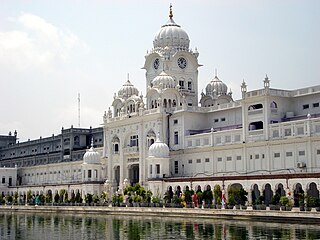
Sarbat Khalsa, was a biannual deliberative assembly of the Sikhs held at Amritsar in Panjab during the 18th century. It literally translates to the "entire Sikh Nation" but as a political institution it refers to the meetings of the Dal Khalsa, Sikh Misls, and the legislature of the Sikh Empire.The first Sarbat Khalsa was called by the tenth guru, Guru Gobind Singh before his death in 1708 and the tradition of calling Sarbat Khalsa has continued ever since at times of hardship or conflict. After the demolition of the Mahant System by the Khalsa Panth, S. Kartar Singh Jhabbar called the Sarbat Khalsa in 1920. He was not the Jathedar of Sri Akaal Takhat Sahib but a Sikh leader. In the resolution of that Sarbat Khalsa, Teja Singh Bhuchhar was announced as the Jathedar of Sri Akaal Takhat Sahib. Next known meeting of the Sarbat Khalsa took place on the occasion of Divali in 1723 when a clash between Tat Khalsa and the Bandais was averted and amicably settled through the intervention and wise counsel of Bhai Mani Singh.

Mai Bhago also known as Mai Bhag Kaur was a Sikh woman who led Sikh soldiers against the Mughals in 1705. She was an exceptionally skilled warrior on the battlefield and is revered as a saint in Sikhism. She was known for rallying the 40 Sikhs who abandoned Guru Gobind Singh at the siege of Anandpur Sahib and bringing them back to fight.
Template:Infobox Gurudwara Gurdwara Sri Guru Gobind Singh Ghat situated on the bank of river Ganges is hardly 200 yards from Takht Sri Patna Sahib. It is also popular as Kangan Ghat where child Guru Gobind Singh had thrown his gold bangle. On the same bank child Guru Gobind Singh had blessed mental peace to Pandit Shiv Dutt, by giving him the knowledge of Sri Guru Granth Sahib ji.Guru Sahib ji taught him what 9 gurus had preached.

Gurdwara Bal Lila Maini in a narrow lane close to Takht Sri Harmandir Sahib marks the house where King Fateh Chand Maini lived. His childless Queen had developed special fondness for the young Guru Gobind Singh, who, too, often came here to sit in the Queen's lap giving her immense delight and spiritual solace. She fed the Child Gobind and his playmates, at his demand, with boiled and salted gram.Even now boiled and salted gram is served as prasad in this Gurdwara, which, unlike the other shrines in Patna Sahib, is served by Nirmala Sikhs. A wood carving on the old front door is dated 28 August 1668, but the hall housing the sanctum and other blocks of rooms in the inner compound have been reconstructed during recent decades.

About three kilometers east of Takht Sri Harmandir Sahib is where Guru Tegh Bahadur first alighted in a garden (bagh) belonging to Nawabs Rahim Bakhsh and Karim Bakhsh, nobles of Patna, and where the sangat of Patna along with the young Guru Gobind Singh came out to receive him back from his four-year-long odyssey. A shrine commemorative of the first meeting of Tegh Bahadur and Gobind Singh was established here. Its present building was constructed during the 1970s and 1980s. An old well still in use and a dried stump of the imli tree under which the sangat met Guru Tegh Bahadur still exist.

Gurdwara Damdama Sahib is a gurdwara located near Humayun's Tomb on the Outer Ring Road in New Delhi, India.

"Guru Maneyo Granth" refers to the historic statement of the 10th Sikh Guru, Guru Gobind Singh (1666–1708), shortly before his demise, on affirming the sacred scripture Adi Granth as his successor, thus terminating the line of human Gurus. Installed as the Guru Granth Sahib, it is now the central holy scripture of Sikhism, and the eternal living Guru of all Sikhs. It is central to Sikh worship as it is said to imbibe the one light of the creator manifested in the Ten Sikh Gurus - one spirit in ten forms.
Animal sacrifice among Nihang Sikhs employs technique of Jhatka is practiced by certain sects within Sikhism on certain religious events. This sacrifice is now only popular among Nihangs and Hazuri Sikhs who sacrifice goats on the festivals of Diwali and Hola Mohalla and distribute it as Mahaprashad among the congregants as part of Langar.
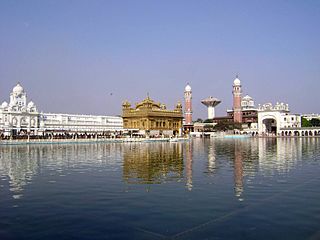
Takht or Taḵẖata, which literally means a throne or seat of authority, is a relic of the religion of Sikhism. There are five Takhts and these Takhts are five gurudwaras which have a very special significance for the Sikh community. The first and the most important one was established by Guru Hargobind in 1609. It is called 'Akal Takht' and is situated just opposite the gate of Harmandir Sahib – The Golden Temple, Amritsar. While the Harmandir Sahib, or Golden Temple, represents Sikh spiritual guidance, the Akal Takht symbolizes the dispensing of justice and temporal activity. It is the highest seat of temporal authority of the Khalsa and the seat of the Sikh religion's earthly authority. Here the Guru held his court and decided matters of military strategy and political policy. Later on, the Sikh Nation took decisions here on matters of peace and war and settled disputes between the various Sikh groups. The Sarangi singers sung the ballads of the Sikh Gurus and warriors at this place and robes of honour (saropas) were awarded to persons who rendered distinguished services of the community of men in general. From December 2010, The Deccan Odyssey train, taken on charter from Government of Maharashtra started with aim to have a journey across four Sikh takhts, with a flight by devout and sightseers to the fifth takht. A special train named Panj Takht Special train for the pilgrimage of five Sikh takhts, was flagged off on 16 February 2014.

Tourism in Marathwada refers to tourism in Marathwada region of Maharashtra state of India. Aurangabad city is a regional headquarter of Marathwada and tourism capital of Maharashtra state. Out of 4 UNESCO World Heritage Sites in Maharashtra, 2 of them are in Marathwada. Also there are 110 monuments in Marathwada which are protected by Government of Maharashtra and recognized by Archaeological Survey of India. Marathwada is also important region for Religious tourism, out of 12 Jyotirlingas of Hindu God Shiva, 3 are in Marathwada. Hazur Sahib Nanded is the second holiest place in Sikhism after Harminder Sahib of Amritsir. There are also sufi shrines in Marathwada, most famous among them is Turabul Haq Dargah at Parbhani where thousands of people of all religion visits dargah annually. Pathri in Parbhani district is birthplace of Sai Baba of Shirdi and Sai Baba Birth Temple in Pathri is one of major religious tourism place in Marathwada.

The 350th Prakash Parv or birth anniversary of Guru Gobind Singh ji was celebrated in January 2017 in Patna, India. 2017 is the year of the 350th anniversary of the 10th Sikh Guru, a spiritual master, warrior, poet and philosopher. At the date of this anniversary, a number of events was organized on the occasion in Patna marking a grand celebration in their history.


